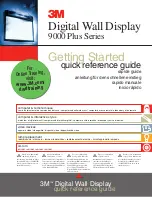
Installation and Setup
Mirage 4K25 Setup Guide
20
020-101362-02 Rev. 1 (01-2015)
Setup the lamp
The lamp position can be adjusted at any time, using a set of electronically controlled motors. An
optimal position for the lamp, with respect to the reflector and the integrator rod, results in
maximum brightness. This geometry is software controlled using the LampLOC calibration process.
3D setup for Mirage projectors
The Mirage projector is capable of displaying stereoscopic 3D video sources, relying on additional
hardware (stereo emitters and glasses) to complete the display system.
Images generated from a stereo 3D video source consist of a series of images (frames) that
alternate quickly between two slightly different viewpoints, corresponding to our left and right eyes.
When these frames are displayed fast enough and viewed with special glasses synchronized to the
left/right (L/R) changes, the resulting image appears with the same depth and perspective sense in
the real world.
3D requirements
Stereo 3D applications require a stereo 3D-capable source, special hardware and software setups,
and the projector’s 3D Settings menu option to control the projector’s processing, synchronization,
and displaying of the stereoscopic 3D source material.
Hardware requirements
Note the following hardware requirements for stereo 3D applications:
• Christie Digital Systems Mirage 4K Series projector
• 3D stereo sync cable for Direct-Input 3D (and frame doubled)
• A source, usually a computer with a 3D graphics card(s)
• Emitter for controlling active shutter glasses
or
A qualified device that mounts in front of the lens of the projector to process the light from the
lens into a passive polarized light. Contact your Immersive dealer for more information.
Software and content requirements
Note the following software and content requirements for stereo 3D applications:
• Any 3D computer software that supports 3D stereo on a supported computer(s) with associated
graphic cards (suggested cards include ATI or NVIDIA)
• A video stream from a video source prepared to be sequential content (for Direct-Input 3D) or
two video streams from a video source that has been prepared to be supplied left eye and right
eye concurrently and frame locked (Dual-Input 3D)
i
The type of 3D glasses can be active or passive stereo depending on the type of stereo controllers and
screen used.
















































